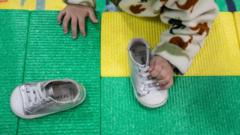South Korea's continuing battle with low birth rates has unexpectedly fueled a boom in fertility clinics across the nation. Kim Mi-ae, a 36-year-old Seoul resident, illustrates the growing trend, recounting her experience with in vitro fertilization (IVF) that comes with long wait times, reflecting a collective desire among couples to start families. As the birth rate fell to a record low of 0.72 babies per woman in 2023, the demand for fertility solutions across South Korea shot up dramatically.
Fertility treatments grew nearly 50% from 2018 to 2022, amounting to 200,000 procedures, with a notable trend: one in six babies born in Seoul received fertility treatment. Experts attribute this rise not solely to a need for assistance with conception but also to a significant shift in societal attitudes towards family planning. The younger generation is increasingly in control of their reproductive choices, opting to freeze eggs or pursue IVF more proactively compared to previous generations.
This new understanding of family planning has emerged against the backdrop of South Korea's demographic crisis, where nearly a fifth of the population is aged 65 or older. After years of decline, there seems to be a glimmer of hope as the birth rate rose slightly to 0.75 in 2024—its first increase in nearly a decade. However, experts urge caution, as this uptick might not signal a substantial reversal in the trend.
Factors contributing to this long-standing crisis include financial stress, high education costs, and traditional gender roles, which often place child-rearing responsibilities primarily on women. Yet more than half of South Koreans want children, albeit feeling financially inadequate to raise them. The average age of first-time mothers in South Korea is around 33.6 years old, a statistic indicative of the delayed timing when many couples begin to build families.
Despite government subsidies for fertility treatments, costs remain high, complicating access for many. For instance, Ms. Kim, seeking IVF, found the out-of-pocket expenses daunting. Even with financial support that aims to mitigate these burdens, women frequently balance demanding careers while navigating the complexities of undergoing fertility treatments.
Indeed, the increasing reliance on IVF has unveiled a new social issue. Women often face workplace pressure that challenges their commitment to necessary treatment schedules. For many, including Jang Sae-ryeon, opting for fertility treatment can mean difficult decisions regarding employment, further complicating an already challenging journey.
Yet, amidst these struggles, the desire for families remains strong. Both Kim and Jang capture the emotional weight behind their journeys, revealing the profound hope they have for creating families. The evolving landscape of fertility in South Korea reflects both the trials of the current generation and their tireless pursuit of parenthood, a desire that continues to shape the future of the nation.
Fertility treatments grew nearly 50% from 2018 to 2022, amounting to 200,000 procedures, with a notable trend: one in six babies born in Seoul received fertility treatment. Experts attribute this rise not solely to a need for assistance with conception but also to a significant shift in societal attitudes towards family planning. The younger generation is increasingly in control of their reproductive choices, opting to freeze eggs or pursue IVF more proactively compared to previous generations.
This new understanding of family planning has emerged against the backdrop of South Korea's demographic crisis, where nearly a fifth of the population is aged 65 or older. After years of decline, there seems to be a glimmer of hope as the birth rate rose slightly to 0.75 in 2024—its first increase in nearly a decade. However, experts urge caution, as this uptick might not signal a substantial reversal in the trend.
Factors contributing to this long-standing crisis include financial stress, high education costs, and traditional gender roles, which often place child-rearing responsibilities primarily on women. Yet more than half of South Koreans want children, albeit feeling financially inadequate to raise them. The average age of first-time mothers in South Korea is around 33.6 years old, a statistic indicative of the delayed timing when many couples begin to build families.
Despite government subsidies for fertility treatments, costs remain high, complicating access for many. For instance, Ms. Kim, seeking IVF, found the out-of-pocket expenses daunting. Even with financial support that aims to mitigate these burdens, women frequently balance demanding careers while navigating the complexities of undergoing fertility treatments.
Indeed, the increasing reliance on IVF has unveiled a new social issue. Women often face workplace pressure that challenges their commitment to necessary treatment schedules. For many, including Jang Sae-ryeon, opting for fertility treatment can mean difficult decisions regarding employment, further complicating an already challenging journey.
Yet, amidst these struggles, the desire for families remains strong. Both Kim and Jang capture the emotional weight behind their journeys, revealing the profound hope they have for creating families. The evolving landscape of fertility in South Korea reflects both the trials of the current generation and their tireless pursuit of parenthood, a desire that continues to shape the future of the nation.


















